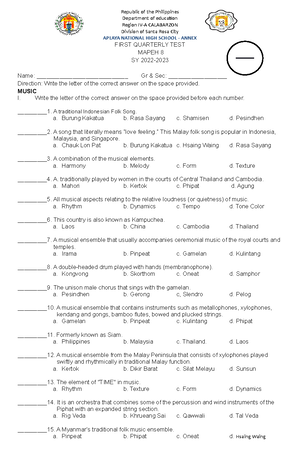- Information
- AI Chat
Was this document helpful?
Definition of Physical Education
Course: Physical Education (PE 101)
113 Documents
Students shared 113 documents in this course
University: Laguna State Polytechnic University
Was this document helpful?

DEFINITION
-Physical education is a course taught in school that focuses on developing physical fitness and the ability to
perform and enjoy day-to-day physical activities with ease.
- instruction in the development and care of the body ranging from simple calisthenic exercises to a course of
study providing training in hygiene, gymnastics, and the performance and management of athletic games
HISTORY
-A brief history of physical education in the United States would kick off in the nineteenth century. There
was growing popularity of formal physical education programs all across Europe where calisthenics and
gymnastics were all the rage. American schools looked to follow the European model by incorporating
physical education into the curriculum for primary and secondary schools. And a brief history of physical
education would not be complete with a consideration of institutes of higher education that gradually
built up extremely successful sports programs.
-How it began
The brief history of physical education would start in just about 1820 when schools focused on
gymnastics, hygiene training and care and development of the human body. By the year 1950, over 400
institutes had introduced majors in physical education. The Young Men's Christian Association launched
its very first chapter in 1851 and focused on physical activities. Colleges were encouraged to focus on
intramural sports particularly track, field and football.
But physical education became a formal requirement following the civil war when many states opted to
pass laws that required schools to incorporate a substantial physical education component into their
curriculums. But it was not till 1970 that an amendment was made to the Federal Education Act that
allowed women from high school and college to compete in athletic competitions. Sex-based
discrimination was completely outlawed from government funded programs at this point.
Physical Education in college
College athletics received a major stimulus when a National Collegiate Athletic Association was created
in the early twentieth centuries. There was a rise in popularity of sports within colleges and universities
and funding greatly increased. Colleges took great pride in their athletic programs and
sports scholarships became a norm. There was also a surge in people who enrolled in sports education
programs to meet the growing demand for professionals in the field.
Decline in Physical Education
But this is not meant to imply that the history of physical education has been all rosy. Late in the
twentieth century there was certainly a decline in the commitment to physical education. The growing
offering of extra subjects and electives in schools means that the shift was focusing away from physical
education and towards academics. The country also faced a recession around 1970 and 1980 and the
dearth of government funding means that physical education programs were often the first to be cut
from schools and universities.
The modern age
But recent awareness of the need for balanced curriculums particularly given the national concern over
the state of obesity and children's attention towards non-physical activities like video games has
brought physical education back in the spotlight. The government has re-signaled its commitment to
physical education by making it mandatory in public schools in early classes. But it remains an elective
at the high school level. One of the most interesting developments in the history of physical education
has been how the definition of physical education has evolved. While it only encompassed traditional
sports in the beginning, it now includes several less physical activities such as yoga and meditation
which are considered critical to helping students develop a sense of control in such a stressful age.





